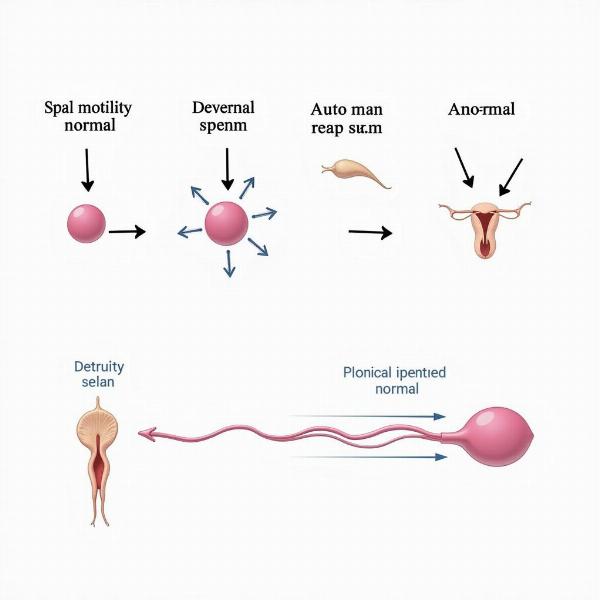Understanding sperm concentration is crucial for couples trying to conceive. This article will delve into the meaning of “sperm concentration” in Hindi, its significance in fertility, and related terminology. We’ll explore the various factors affecting sperm concentration and provide valuable insights for those seeking to understand this important aspect of male reproductive health.
Understanding “Sperm Concentration” (वीर्य की सघनता)
In Hindi, sperm concentration is referred to as “वीर्य की सघनता” (veerya kee saghanata). This term directly translates to “density of semen,” reflecting the number of sperm present in a specific volume of semen. A healthy sperm concentration is essential for fertilization. Many couples struggle with infertility due to low sperm count, highlighting the importance of understanding this concept. Knowing what constitutes a normal sperm concentration can empower individuals to seek timely medical advice and support if needed.
What is a Normal Sperm Concentration?
A normal sperm concentration typically falls within the range of 15 million to 200 million sperm per milliliter (ml) of semen. Values below this range are considered low and can significantly impact fertility. While having a higher concentration within the normal range is generally advantageous, exceeding the upper limit doesn’t necessarily guarantee increased fertility.
Factors Affecting Sperm Concentration
Several factors can influence sperm concentration. These include:
- Lifestyle choices: Smoking, excessive alcohol consumption, and drug use can negatively impact sperm production.
- Medical conditions: Certain medical conditions like varicocele (enlarged veins in the scrotum) and hormonal imbalances can affect sperm concentration.
- Environmental factors: Exposure to toxins, radiation, and excessive heat can also reduce sperm concentration.
- Nutritional deficiencies: A balanced diet rich in essential nutrients is crucial for healthy sperm production.
Sperm Concentration vs. Sperm Count: What’s the Difference?
While often used interchangeably, sperm concentration and sperm count are distinct measures. Sperm concentration, as discussed, refers to the number of sperm per milliliter of semen. Sperm count, on the other hand, represents the total number of sperm in the entire ejaculate. Both measurements are essential for assessing male fertility. Understanding the distinction can help clarify diagnostic results and treatment options. For instance, a lower semen volume with normal concentration could still result in a low total sperm count.
Sperm Motility and Morphology: The Other Pieces of the Puzzle
Besides sperm concentration, two other crucial factors contribute to fertility: sperm motility (the ability of sperm to swim effectively) and sperm morphology (the size and shape of sperm). These three parameters – concentration, motility, and morphology – are assessed during a semen analysis, a standard test for evaluating male fertility.
 Sperm motility and morphology
Sperm motility and morphology
Why is Knowing the Meaning of “Sperm Concentration” in Hindi Important?
Understanding the meaning and significance of sperm concentration can be especially crucial in a culturally diverse country like India, where communication about sensitive health topics might be challenging. Knowing the appropriate terminology in Hindi empowers individuals to discuss their concerns openly with healthcare professionals and seek appropriate guidance. This knowledge also promotes awareness and encourages couples to address potential fertility issues proactively.
Conclusion
“Sperm concentration” (वीर्य की सघनता) is a vital concept in understanding male fertility. Factors like lifestyle, medical conditions, and environmental influences can affect sperm concentration, which, along with motility and morphology, plays a critical role in conception. Knowing this information empowers individuals to make informed decisions about their reproductive health and seek appropriate medical advice when necessary.
FAQs
- What is the ideal sperm concentration for pregnancy? While a concentration within the normal range (15-200 million/ml) is desirable, achieving pregnancy depends on various factors, including sperm motility and morphology.
- How is sperm concentration measured? Sperm concentration is measured through a semen analysis performed in a laboratory.
- Can low sperm concentration be treated? Depending on the underlying cause, various treatments are available for low sperm concentration, ranging from lifestyle modifications to medical interventions.
- What does “veerya kee saghanata” mean in English? “Veerya kee saghanata” translates to “sperm concentration” or “density of semen.”
- Does high sperm concentration guarantee pregnancy? No, while it increases the chances, other factors like sperm motility and female fertility also play a crucial role.
- How can I improve my sperm concentration? Maintaining a healthy lifestyle, including a balanced diet, regular exercise, and avoiding smoking and excessive alcohol consumption, can positively impact sperm concentration.
- When should I consult a doctor about sperm concentration? If you and your partner have been trying to conceive for a year without success, it’s recommended to consult a doctor for fertility evaluation.
Related Articles:
fertile window meaning in hindi
chemotropic meaning in hindi
asthenospermia meaning in hindi
Meaning-Hindi.in is your one-stop solution for all your Hindi translation needs. We offer a wide range of translation services, including business and commercial document translation, certified and legal document translation, technical and user manual translation, website and localization translation, educational and academic document translation, express translation, and specialized translation. Need accurate and reliable Hindi translations? Contact us today! Email: [email protected], Phone: +91 11-4502-7584. Get in touch with Meaning-Hindi.in today for all your translation needs!